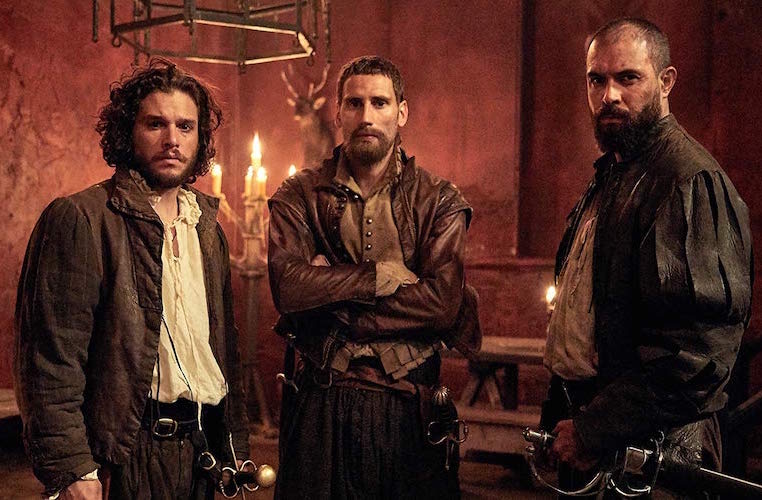On Thursday, May 20, 1604, five Catholic men gathered at a house behind St. Clement’s Inn to rage against the decades of repression suffered by their friends and families, nursing their grievances against the new Protestant king of England, James I. Earlier, one of them, Robert Catesby, had told them of his desire, which was to strike back against the king, his ministers, and the entire ruling class by blowing up the Houses of Parliament with gunpowder they stashed beneath the building. His cousin, Thomas Wintour, had recoiled at the scale of the slaughter and asked whether it was necessary. Catesby had assured him it was, for “the nature of the disease required so sharp a remedy.”
Another conspirator, Thomas Percy, reacted to criticism of the plan with the anguished cry, “Shall we always, gentlemen, talk and never do anything?”
Get Our Newsletter
With that, they agreed and took an oath of secrecy, setting themselves on a tragic course that would end in failure when Guy “Guido” Fawkes, another of the core five plotters, was discovered just before midnight on November 4, 1605. Fawkes was standing in a cellar next to thirty-six barrels of gunpowder that, when lit, could have detonated the House of Lords and, as Fawkes defiantly snarled under interrogation: “blow the beggarly Scots back to their native mountain.” The five men would all die, executed for high treason with noted ferocity, either on the scaffold or shot and killed by the king’s soldiers who tracked them down.
The planned date of the explosion, November 5th, became a holiday celebrating providential delivery, with the visage of Guy Fawkes passing into a bizarre form of immortality. The Gunpowder Plot itself has taken a place in the culture that, at different junctures, seems both more and less important than the actual historical events: conspiracy, detection, and punishment.
“Remember, remember, the 5th of November: gunpowder, treason, and plot.” English children learned those words when very young. By the nineteenth century they delighted to buy a Guy Fawkes mask, which often came with candy. As for the adults, on Guy Fawkes Day, they paraded around with an effigy too, one that would be burned at night in a bonfire, celebrating the nation’s triumph over a dark and terrible plot.

But in the late twentieth century, the significance behind donning a Guy Fawkes mask morphed. It wasn’t play-acting the part of a hated criminal but expressing sympathy for a lone person who sought to strike out at those in power in an act of over-the-top, perhaps-doomed-to-fail violence. The long, white, leering, mustachioed mask now familiar to many was created by illustrator David Lloyd to accompany the dystopian graphic novel series V for Vendetta, written by Alan Moore, which began its run in 1982.
The comic was adapted by the filmmaker sisters the Wachowskis, Lana and Lilly, who wrote an adaptation in the mid-1990s but shelved it for a decade to work on their Matrix trilogy. They then moved the period of Vendetta to around 2020, and hired a Matrix protégé, James McTeigue, to direct.
The film opens to the sound of Natalie Portman’s voice chanting the Gunpowder Plot rhyme, before saying, “But what of the man? I know his name was Guy Fawkes, and I know in 1605 he attempted to blow up the Houses of Parliament. But who was he really and what was he like?” The plot then dives into the story of a vigilante using terrorist tactics to fight a fascist government. In the end, thousands of people wearing long black capes and Guy Fawkes masks march on Parliament. The buildings blow up, to the tune of the 1812 Overture.
As David Denby wrote in The New Yorker, “As far as one can tell, Moore and Lloyd’s work was fuelled by the British left’s disgust with [Margaret] Thatcher’s policies, combined with imaginary menaces culled from antic British tabloids.” As for the film, Denby panned it as “a dunderheaded pop fantasia that celebrates terrorism and destruction… perhaps the ultimate example of how a project with modest origins becomes a media monster.”
However, the evolution of the face of Guy Fawkes was not over. Hacktivists first appropriated masks similar to V for Vendetta’s when taking on Scientology in 2008. Anonymous, the leaderless Internet group that attacks political corruption, corporate greed, and child pornography, often dons the face of Guy Fawkes when communicating with the world.
In one Anonymous video available on YouTube, a disguised man using a voice modulator says that
it is time to explain the meaning behind the Guy Fawkes mask again. From the limited viewpoint of the rather common citizen, while it seems there is always a war somewhere on this planet, we live in a particularly turbulent time… of injustice and greed… The Guy Fawkes mask… [has direct links] to the Anonymous movement, which has become a means for anyone and everyone to take a stand against whatever issues they feel passionate about, be it global warming or corporate corruption.
In some quarters, this appropriation has been met with stunned disbelief. Jonn Elledge wrote in The New Statesman in 2015 that “[t]he Guy Fawkes mask has become the symbol of left-wing anti-government protests far and wide, including hacktivists Anonymous and the Occupy Movement… This is… based not so much on a misreading of history as on a complete ignorance of it. Guy Fawkes was many things, but one he emphatically wasn’t was a freedom fighter.”
As those familiar with seventeenth-century history try to remind everyone, Fawkes and the other conspirators of the Gunpowder Plot did not want to do away with a hereditary monarch. That kind of resentment of royal rule and determination to eliminate it first took shape in England more than thirty years later, with the Civil War that broke out against James’s son, Charles I.
No, Catesby, Percy, Fawkes, and the others were essentially royalist—they just wanted a different king. The conspirators believed that in the chaos of an incinerated House of Parliament they could replace the dead King James with his daughter, the nine-year-old Princess Elizabeth. The country would be ruled not by her but by an adult regent—royal interrogators never could find out who the plotters planned to recruit for the job. Under a new ruler, the laws against Catholics would be stricken from the books and other wrongs made right, they believed.
Scholarship on the Gunpowder Plot has been surprisingly scarce until fairly recently. It was almost as if historians did not rate the plotters as serious enough political players to warrant much study. In his article “Strategy and Motivation in the Gunpowder Plot,” historian Mark Nicholls quotes the late historian Hugh Trevor-Roper’s description of the Gunpowder Plot conspirators as “the idiot fringe of the indebted gentry.”
But were they nothing but fantasists and fools? Over the course of the last twenty-five years, a number of writers, documentarians, and filmmakers have taken a new look at the Gunpowder conspirators in the context of their time, a period of religious persecution, massacres, and finally wars pitting Catholic against Protestant.
The same rage and resentment that gave birth to this group’s 1605 plot to blow up the House of Parliament would continue to build throughout Europe until the Thirty Years War exploded. The Protestant and Catholic states’ fight for dominance claimed the lives of some 8 million people.
In her book Faith and Treason, the historian Antonia Fraser analyzes the religious tensions of the late sixteenth century that broke out in violence across Europe. Killing a monarch was not unusual in this time. In France, both Henry III and Henry IV were assassinated for religious reasons, as was William the Silent of the Netherlands.
It was Elizabeth I’s treatment of Catholics that directly led to the Gunpowder Plot. After her excommunication by the Pope, the Protestant Queen feared rebellion, and even assassination at the hands of Catholics, or “Papists,” and her principal secretary Sir Francis Walsingham set up a spy network. Walsingham tirelessly sought out the Jesuits who infiltrated the country to perform Catholic mass in secret and foment rebellion. Jesuits who were caught were often tortured in the Tower of London by an undoubted sadist working for the government, Sir Richard Topcliffe.
Catholic subjects who declined to attend Protestant services were fined heavily and watched carefully. If they persisted and violated any laws by doing so, their property was confiscated. They did not hold important positions in government. “In her long reign, penalties had increased, at a pace which was sometimes slow, sometimes violently accelerated, always destined to make Catholic lives ever more painful, powerless, and poverty stricken,” Fraser writes.
The historian Roger Bigelow Merriman writes in The American Historical Review, that, from Elizabeth I’s perspective, “[t]he measures which they took against the English Romanists were all primarily intended to promote the safety and strength of the realm or to enrich the crown.”
But these measures were very hard to bear for Catholic families, and they looked to the reign of her probable successor, James VI of Scotland, with longing. After all, James was the son of Mary Queen of Scots, revered as a Catholic martyr. Elizabeth did not write a will or openly name who would come after her, so James did a fair amount of lobbying for the job, in person or in letters, to drum up support during Elizabeth’s old age. There is little doubt that James courted the Catholics of England through vague promises of greater toleration. After Elizabeth died and he took the throne as James I, that support withered. In fact, he reinforced the strictest penal laws. This was the tipping point for Robert Catesby.

Contemporaries agree that Catesby was a man of great personal charisma. As if to drive that point home he was portrayed last year in the HBO series Gunpowder by Kit Harington, who also plays Jon Snow in the hit series Game of Thrones. More than any other fictionalized portrait to date, the Gunpowder Plotters in the three-part series are shown as honorable, brave, and pious men fighting for a cause.
The series opens with Catesby taking the Sacrament with extended family, served by priests they are forced to hide from the government. But the queen’s men arrive, pounding on the door, and after hours of searching, they drag out a hidden priest. In a subsequent scene, the woman concealing the priest in question is punished with a public execution. She is stripped naked and pressed to death by heavy planks.
When Gunpowder premiered, there was criticism of the gruesomeness of this scene. But Harington, who is descended from Catesby, and the filmmakers were unapologetic. The execution closely follows that of a real woman killed for her Catholic beliefs, Margaret Clitherow. There is little embellishment in the violence meted out onscreen or in Gunpowder’s depiction of the extent of the repression. The intent of the series was to reveal, straight up, the Catholic point of the view of the Gunpowder Plot, which even today some reviewers found uncomfortable.
“I am humiliated, impoverished, and despised,” Harington-as-Catesby cries out in one scene, as justification for his plotting.
However, in showing Catesby’s fate with honesty—the conspiracy is revealed, few rally to their cause, he is tracked down and shot dead—Harington, perhaps unintentionally, underscores the difference between truth and fiction. In Game of Thrones, his heroic character Jon Snow overcomes impossible odds, even coming back from the dead. But Robert Catesby was destroyed, and he took a great many people down with him. As V for Vendetta says, “Four hundred years later, an idea can still change the world.”
Editor’s Note: This story was amended to correct an error in naming: it was Margaret Clitherow who was pressed to death in 1586; Lady Dorothy Dibdale is the fictional character in Gunpowder who suffers the same fate. In addition, the title 1812 Overture was italicized, and a missing hyphen was added.







